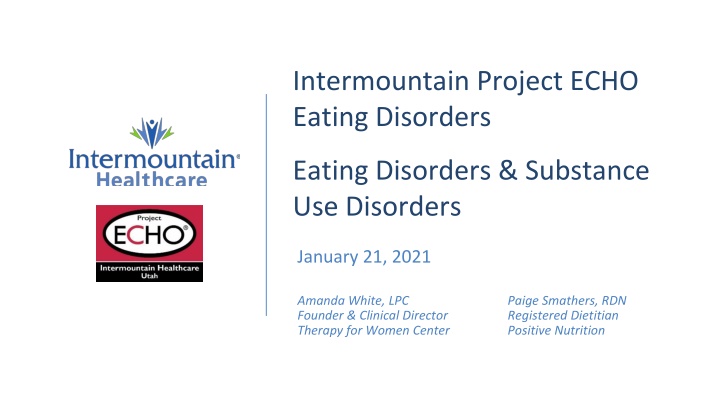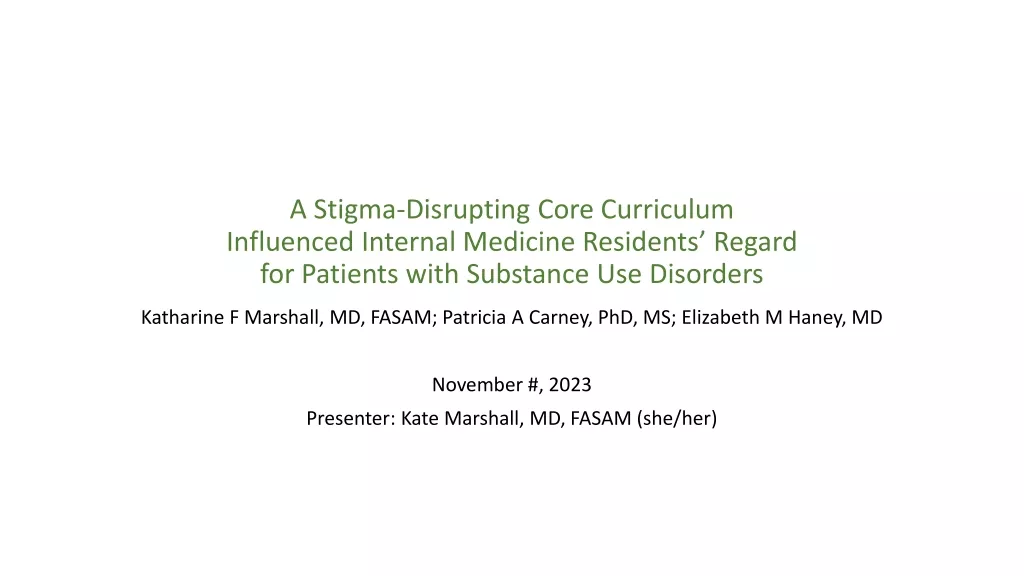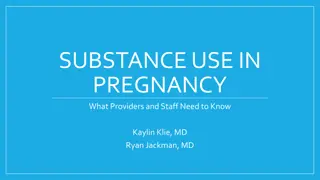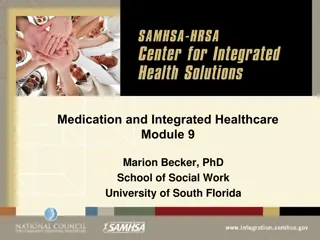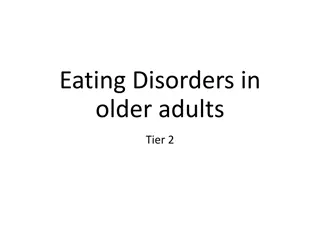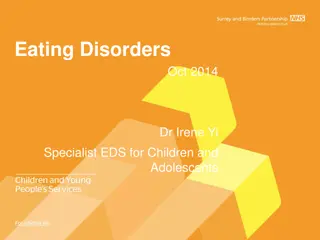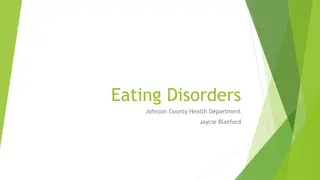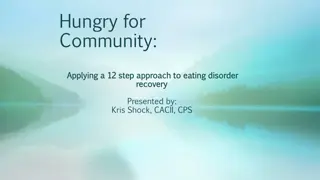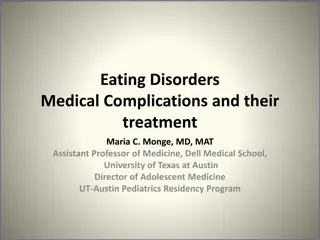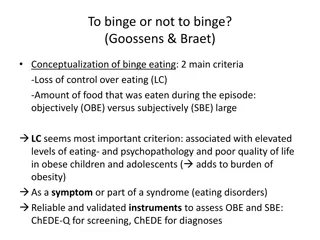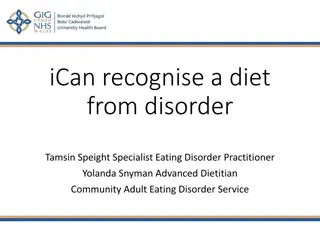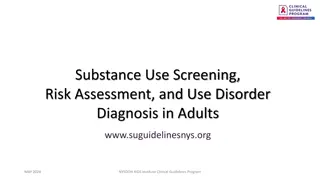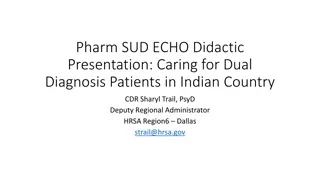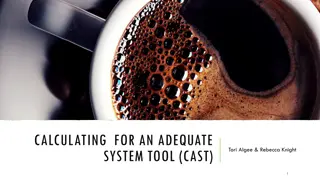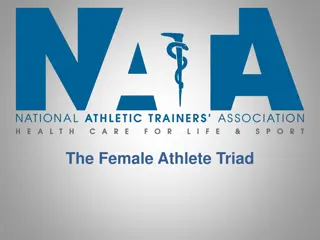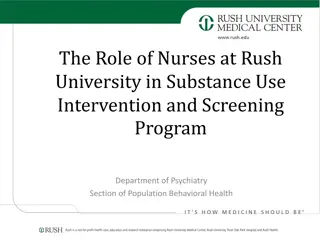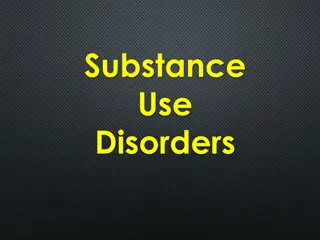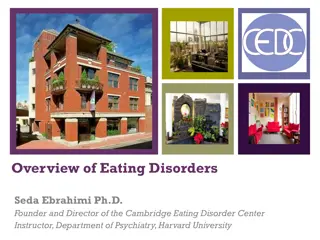Clinical Differences in Eating Disorders & Substance Use Disorders
This presentation by Amanda White, LPC, and Paige Smathers, RDN, explores the similarities and differences between eating disorders and substance use disorders. They discuss risk factors for relapse and introduce weight-neutral nutrition interventions to support recovery. Learn about their expertise and the objectives of this educational session.
Download Presentation

Please find below an Image/Link to download the presentation.
The content on the website is provided AS IS for your information and personal use only. It may not be sold, licensed, or shared on other websites without obtaining consent from the author.If you encounter any issues during the download, it is possible that the publisher has removed the file from their server.
You are allowed to download the files provided on this website for personal or commercial use, subject to the condition that they are used lawfully. All files are the property of their respective owners.
The content on the website is provided AS IS for your information and personal use only. It may not be sold, licensed, or shared on other websites without obtaining consent from the author.
E N D
Presentation Transcript
Intermountain Project ECHO Eating Disorders Eating Disorders & Substance Use Disorders January 21, 2021 Amanda White, LPC Founder & Clinical Director Therapy for Women Center Paige Smathers, RDN Registered Dietitian Positive Nutrition
Disclosure The content of this presentation does not relate to any product of a commercial entity; therefore, I have no relationships to report. Off-label indications will not be discussed.
Disclosure Amanda E. White has a commercial relationship with the following: Forthcoming book with HachetteGo (an imprint of Hachette Books)
Objectives At the conclusion of this activity, participants should be able to successfully: Understand the clinical differences and similarities between Eating Disorders and Substance Use Disorders Identify the risk factors for relapse Implement weight-neutral nutrition interventions to support nutritional rehabilitation and recovery
About Amanda E. White Licensed Professional Counselor (LPC) in Pennsylvania Specialty training in Eating Disorders, Substance Use Disorders, Trauma and their overlap Specialty Therapist at Seabrook, and Addiction Rehab running their long term women s program (2.5 years) Founder and Clinical Director of Therapy for Women Center in Philadelphia and serving clients across the country (4 years) Therapy for Women specializes in the in-between and specifically how different mental health issues overlap Author of forthcoming book- Not Drinking Tonight: A Therapist s Guide to Re-Examining Your Relationship with Alcohol Personally in recovery from an eating disorder and substance use disorder
About Paige Smathers Registered Dietitian and owner of the Salt Lake City group practice, Positive Nutrition Specialize in eating disorders, chronic dieting, substance use disorders and gut disorders Spent about 5 years working in a treatment center providing a weekly nutrition group to people in recovery from SUDs Created a curriculum for RDs to use in the treatment setting Have led Academy of Nutrition and Dietetics approved continuing education webinars on the intersection of addictions and eating disorders for dietitians
Prevalence of EDs & SUDs Comorbidity prevalence rates range from 17 to 46% depending on the type of ED and subtype according to a recent article that examined 13 peer reviewed studies (1) This particular study only reviewed articles that classified Anorexia & Bulimia (both subtypes of Anorexia (restricting and purging) Does not include EDNOS or Binge Eating Disorder or Atypical Anorexia Illicit drugs in this study include: cannabis, cocaine, hallucinogens, stimulants, sedatives/hypnotics/anxiolytics, opiates, and other substances (eg, steroids and inhalants)
Taken from SAMSA (Substance Abuse and Mental Health Services Administration) HHS Publication No. (SMA) 10-4617 Clients With Substance Use And Eating Disorders First Printed 2011
Why is there such a high comorbidity rate? Drunkorexia (Ref 2-4) When individuals replace meals with alcohol And or/ when individuals restrict calories after episodes of binge drinking People use drugs and/or alcohol as an appetite suppressant There is a high rate of PTSD and Trauma in both populations (50%) with SUDs and EDS, so likely trauma is an underlying factor Treatment is often sequential (most severe treated first)(7) No empirically validated or treatment protocols or interventions which treat both EDs and SUDs (7) I believe because of the lack of weight neutral care, individuals with SUDs develop EDs later in treatment or through relapse
Limitations of Studies This research is based on models in DSM-5 for Substance Use Disorder and Eating Disorder (leaves out people who do not fit exact criteria) Research is based on self reporting drug and alcohol use or ED symptoms Often individuals do not just have one type of eating disorder or one drug of choice, but it will change based on what is available, relapse patterns and past history Most of the studies are based on individuals who are already in inpatient treatment Data is different between men, women and among different races
Image created by Amanda E. White
Risk Factors for SUDs & ED Co-Morbidity Trauma, especially a diagnosis of PTSD More common among women than men Primarily begins as a desire to control their weight Purging before drinking, restricting before or after drinking Stimulants that suppress appetite: cocaine, adderall, meth Stimulants can become a gateway drug to heroin College students are most at risk or anyone who is binge drinking Anyone with a history of trying to lose weight Individuals with a history of Weight Loss Surgery are 2x as likely to develop AUD (8)
Risk Factors & Relapse It also becomes a barrier in individuals staying in recovery since weight gain is common with stopping substance use -- if underlying body image issues are not treated, individuals are more likely to relapse Recovery programs often encourage restrictive eating patterns and disordered eating which make it more likely for those with a history of ED to relapse Once someone stops engaging in the addictive behavior (drugs, alcohol, ED symptoms), it s critical they start working on other mental health issues: trauma, self-worth, etc. that make up the hidden part of the iceberg If the issues under the surface are not healed, the person is going to need another coping skill (or addiction) to manage addiction switching
Image from Edgewood Health Network
EDs & SUDs Substance use disorders and eating disorders are both addictions, but not in the traditional sense of addiction People often recognize the importance of control in relation to EDs SUDs are also about control (controlling how they feel) Individuals with SUDs become addicted to substances which allow them to control and numb their emotions Restricting, bingeing, purging may be used to manage their emotions
EDs & SUDs For those with EDs, it is not food that is addictive -- the dieting, bingeing, purging, and trying to control one s weight is what is truly addictive -- thus, recovery involves not doing things that try to change or manipulate one s shape or size Unlike drugs or alcohol, food (including sugar) is needed to survive Recovery from drugs or alcohol involves not ingesting these substances and/or abstaining from drugs and alcohol Ex: if someone is addicted to gambling, recovery for them is abstaining from gambling -- the act of gambling is addictive, not the actual chips
What is Diet Culture? Diet Culture is a system of beliefs that worships thinness and equates it to health and moral virtue, which means you can spend your whole life thinking you re irreparably broken just because you don t look like the impossibly thin ideal . - Christy Harrison Image from Quick Trim Weight Loss Clinic
What is Drinking Culture? Drinking culture makes the same promises but is sold to us in a different package. Image from Midori- The Original Melon Liqueur
Nutrition Rehabilitation Regular, consistent, adequate, balanced nutrition -- adequate energy is priority Supplementation likely necessary especially water soluble vitamins (B-vitamins specifically) with someone in recovery from alcoholism Nutrient deficiencies likely with this intersection Many people in the acute stages of recovery from SUDs will have spent days/weeks/months malnourished Weight gain is LIKELY this will be scary The entire multidisciplinary team needs to reinforce weight neutrality through this process both from a SUD and an ED perspective
Id rather be addicted and thin than fat and sober.
Hierarchy of Nutrition Needs Performance Variety Balance Adequacy
Barriers to Adequate Nutrition Significant fear of gaining weight: judgement from family, feelings of worthiness, etc. Conceptualizing ED recovery as the same thing as SUD recovery Gut dysfunction with nutritional rehabilitation Body beliefs Food/nutrition myths
The Dietitians Role in Mitigating Barriers Tease out the differences between SUD recovery and ED recovery You have to eat! Food is meant to be rewarding Significant flaws in the studies on sugar and addiction Language matters: addicted to food vs. falling into certain patterns or habits that aren t serving you Assess sleep, medication titration (how this is affecting appetite, nutrition, body image, etc.), stress, life changes, etc.
The Dietitians Role in Mitigating Barriers Cont. Assess length time in addiction: if the struggle with addiction started at age 15 and is now 35, your patient/client may not have cooking/shopping/planning skills necessary to feed themselves back to basics Bust nutrition myths: my favorite way to approach this is to start with homework to write down all food beliefs, thoughts, ideas, things they ve heard and then systematically work through this together Defusion and building awareness as a positive side effect of this assignment Realistic conversations about what health means and assessing for guilt/shame around how they treated their body during their addiction and/or ED
Conclusions There is a high rate of comorbidity between EDs and SUDs (17-46%), likely higher Women, adolescents and young adults, those with PTSD or history of trauma those with a history of dieting, weight loss surgery, or binge drinking are more at risk to develop a co-occurring diagnosis of ED and SUD Eating Disorders do not have a look People can struggle without us knowing --> provide weight neutral care to anyone who has any symptoms of an ED or SUD We cannot prevent relapse, but clinicians, dietitians and doctors can reduce risks for relapse by being in alignment, providing weight neutral care that focuses on adequate nutrition first
References 1. Erin N. Harrop, G. Alan Marlatt, The comorbidity of substance use disorders and eating disorders in women: Prevalence, etiology, and treatment, Addictive Behaviors, Volume 35, Issue 5 (2010): Pages 392-398, 2. The National Center on Addiction and Substance Abuse (CASA) at Columbia University. Food for Thought: Substance Abuse and Eating Disorders. The National Center on Addiction and Substance Abuse (CASA) Columbia University; New York: 2003 3. Umberg, E.N. , Shader, R.I. , Hsu, L.G. , Greenblatt, D.J. From disordered eating to addiction: the food drug in bulimia nervosa. J Clin Psychopharmacol. 2012; 32(3): 376 89. 4. Babiaz, S, Ward, RM, Brinkman, C (2013) Examination of drunkorexia, excessive exercising and extreme drinking. Journal of Young Investigators 24(4) 5. Pompili, S, Laghi, F, (2018) Drunkorexia: disordered eating behaviors and risky alcohol consumption among Journal of Health Psychology. 2020;25(13-14):2222-2232. 6. Substance Abuse and Mental Health Services Administration. (2011). Clients With Substance Use And Eating Disorders. Advisory, Volume 10, Issue 1 . 7. Elmquist J, Shorey RC, Anderson SE, Temple JR, Stuart GL. The Relationship between Eating Disorder Symptoms and Treatment Rejection among Young Adult Men in Residential Substance Use Treatment. Substance Abuse: Research and Treatment. January 2016. doi:10.4137/SART.S33396
References 8. stlund MP, Backman O, Marsk R, et al. Increased Admission for Alcohol Dependence After Gastric Bypass Surgery Compared With Restrictive Bariatric Surgery. JAMA Surg. 2013;148(4):374 377. doi:10.1001/jamasurg.2013.700
